This guide specifically covers installation on Arch Linux (and derivatives like Manjaro) using pacman. If you’re using a different distribution (Ubuntu, Fedora, etc.), the package names and installation commands will vary. For example:
- Debian/Ubuntu:
apt install fcitx5-mozc - Fedora:
dnf install fcitx5-mozc - OpenSUSE:
zypper install fcitx5-mozc
Always check your distro’s documentation for the correct packages and setup steps. The Fcitx5 configuration (environment variables, themes, etc.) will remain similar across Linux systems.
1. Install Packages
Run the following command to install Fcitx5 and Mozc:
| |
2. Set Environment Variables
Add these lines to your shell config file (~/.bashrc, ~/.zshrc, or ~/.profile):
| |
Apply the changes:
| |
Log out and back in for the variables to take effect.
3. Configure Fcitx5
- Open
fcitx5-configtoolfrom your app menu or terminal. - Click + → Uncheck “Only Show Current Language” → Search “mozc” → Add it.
- Remove unnecessary input methods (e.g., “Keyboard - English”) if desired.
4. Enable Japanese Input
Press Ctrl + Space to toggle between English and Japanese (Hiragana). Test by typing nihongo → にほんご.
5. Install Themes (Optional)
With yay:
| |
Apply themes:
- Right-click the Fcitx5 tray icon → Configure → Addons → Classic UI → Select a skin.
6. Customize Mozc
Right-click the Fcitx5 tray icon → Mozc Settings to adjust:
- Input mode (Romaji/Kana).
- Dictionaries.
- Keyboard shortcuts.
Troubleshooting
- Fcitx5 not starting? Add it to your desktop environment’s autostart.
- Input not working in apps? For Electron apps (e.g., VS Code), add these flags to their
.desktopfile:1--enable-features=UseOzonePlatform --ozone-platform=wayland
Done! You now have a functional Japanese input setup. For advanced options, refer to the Fcitx5 Wiki.
